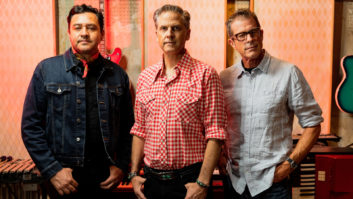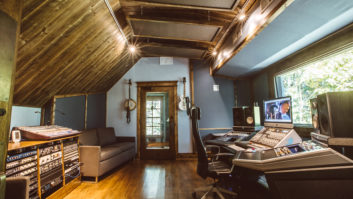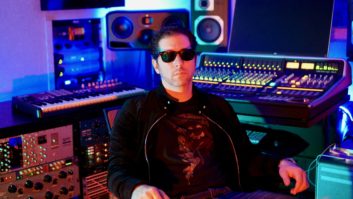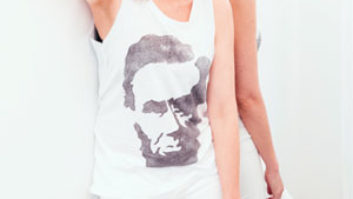Baltic Latvian Universal Electronics (B.L.U.E.) is now shippingits Kiwi multipattern studio condenser mic. B.L.U.E.’stop-of-the-line, solid-state microphone, Kiwi retails at $2,299 andcomes complete with “The Shock,” a robust shock-mountthat resembles an optional $400 unit designed for certain high-endEuropean mics, and a wooden storage box. However, this is nocopycat product: Kiwi offers world-class performance yet has adistinctive character all its own. And it looks like no othermic.
True to their name, B.L.U.E. mics are hand-built in Riga,Latvia. Kiwi’s attractive green body houses modern,transformer-less electronics — a Class-A, all-discrete design(no ICs here!), using high-quality components such as metal filmresistors. The approach is minimalist; the signal path has noattenuation pads or low-cut filters that could compromise thesignal.
The capsule is modeled after the B6 capsule that’s included inB.L.U.E.’s high-end Bottle microphone but in a multipattern versionusing that same large-diaphragm, dual-backplate design. A switch onthe backside of the mic body provides settings for cardioid, omnior figure-8, as well as three intermediate settings between each,for a total of nine patterns. In addition to the outboardshock-mount, Kiwi’s capsule is mounted on a rubber stem, providingnear-total isolation from external vibration and rumblings. Thisinternal mount allows so much flex that the mic includes threehold-down screws to protect the capsule by locking it in placeduring shipping.
Although useful for various studio tasks, Kiwi is designed withvocals in mind. Both the cardioid and the figure-8 patterns arewell-defined and fairly tight, and in most vocal applications, aclick or two away from these end positions on the pattern wheelprovided a wider splay for singers that move around whileperforming.
While tracking lead vocals in cardioid or figure-8, I found theproximity effect added a round fullness up close, but the capsuleis extremely sensitive to vocal pops. Here, either a stocking-typescreen or the way-cool “The Pop” optional ($200!)stainless steel clip-on pop filter is essential. Once you find theexact sweet spot for a full sound without breath noise, the Kiwi issweet. The mic has a wide, smooth presence boost that starts aboutat 6.5 kHz with a +3dB peak around 12 kHz that’s particularly niceon male lead vocals; this boost also adds a nice airiness to maleand female background tracks. Kiwi’s far from flat, but it addspunch, clarity and a low-end warmth on both spoken and singingtracks — a trait that both male and female vocalists liked. Ihad to agree.
This same upper presence bump that I liked on vocals gave a niceemphasis to tenor sax, although it was too much on clarinet —here, a ribbon mic was a better choice. Overall, the mic is fairlybright, and when recording acoustic guitar, some experimentationwith placement is necessary. On a Gibson J-160E acoustic,positioning the mic between the bridge and the soundhole seemed towork the best on solo work, while moving toward the neck offered abrighter sound that kept the guitar from getting lost in a rockmix.
Kiwi was ideal on all kinds of percussion (assuming the drummeris under control) and delivers tons of transients and punch ontimbales, while offering a clean, detailed sound on a brushedsnare. I only had one mic to test, but given the top-end response,I think two Kiwis would be really nice as an overhead pair. Inomni, this detail makes Kiwi a great choice as a room mic, as itcaptures nuances with less coloration than the other patterns.
I used a variety of preamps — both stock console andoutboard — with Kiwi, but I preferred it with the Aphex Model1100, a tube model with a phenomenal -135dBu EIN spec that reallylets you know if the mic electronics are clean or not. Kiwi passedthis test without any problems; in fact, its low-noise (8dBa)performance was perfect for recording low-SPL sources like acousticguitar harmonic grace notes. This, with its impressive ability fordetail and multipattern versatility, makes Kiwi a natural choicefor Foley applications. I could definitely find space in my miclocker for a Kiwi or two!
B.L.U.E. Microphones, 766 Lake-field Road, Suite D, WestlakeVillage, CA 91361; 805/370-1599; fax 805/370-1549; www.bluemic.com.





